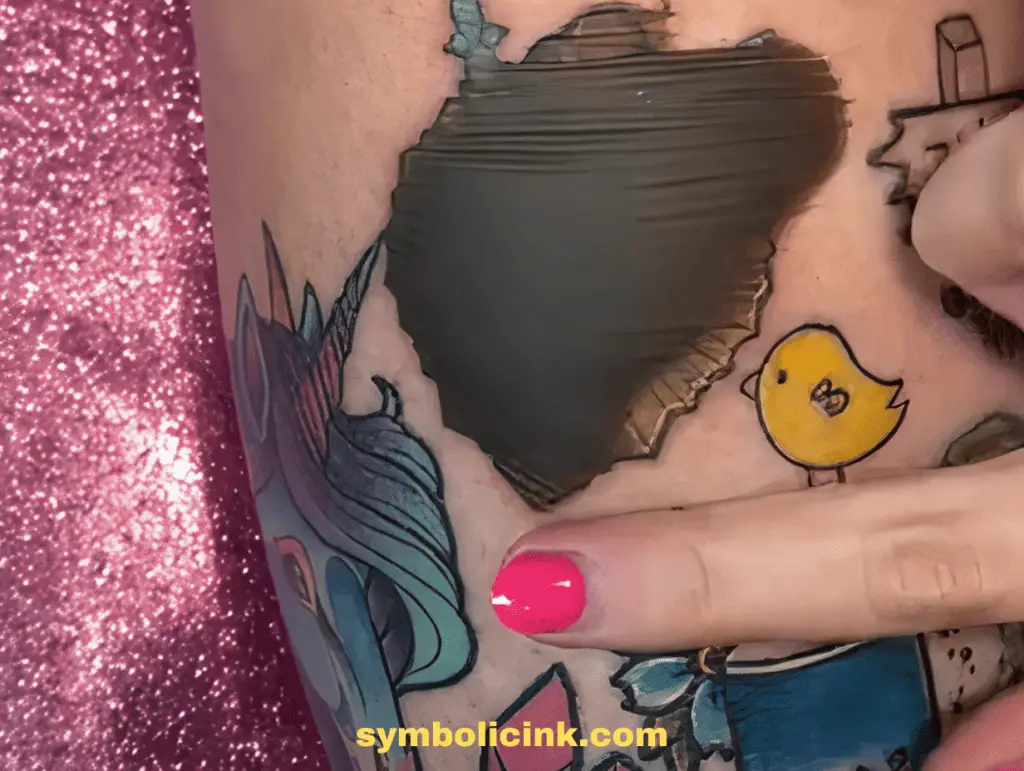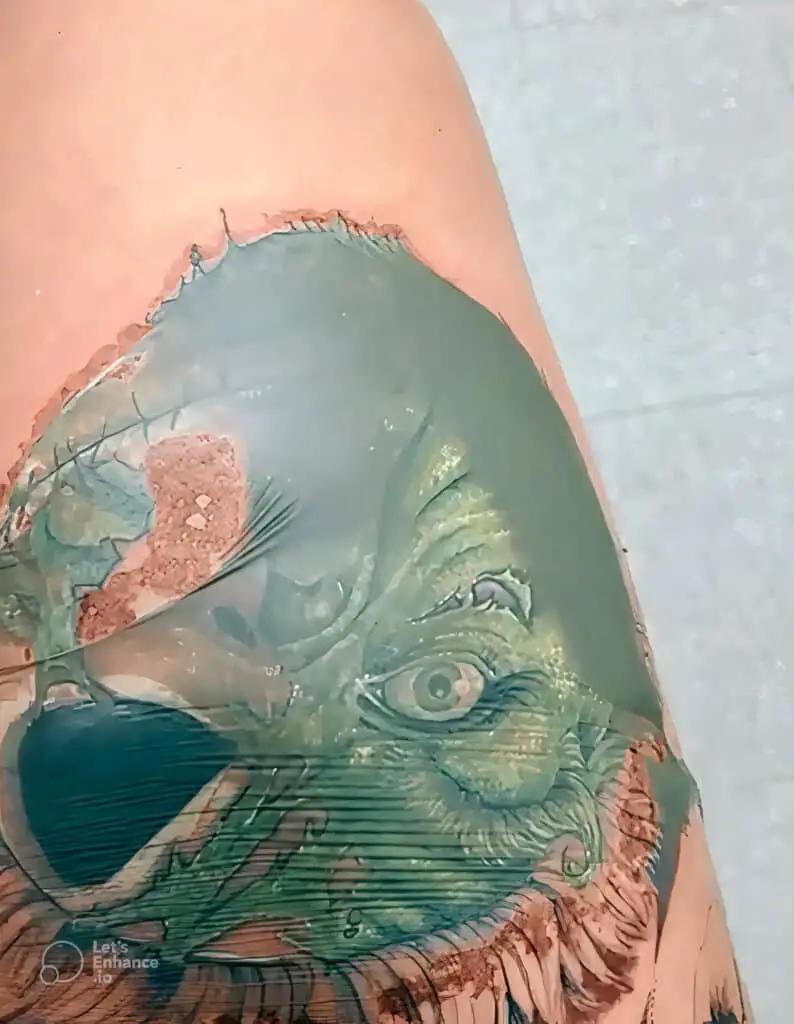If you’re delving into the intriguing world of tattoos, you’ve likely come across an array of terminologies that may leave you scratching your head. One such term is the ink sack.
As puzzling as it may sound, it’s a common phenomenon in the tattoo healing process, and understanding it can make your tattoo journey much smoother. So, what is this ink sack all about? Is it a cause for alarm, or simply a part of the natural healing process?
Join us as we unpack everything you need to know about ink sacks. In this comprehensive guide, we’ll explore their formation, role in healing, common misconceptions, and the dos and don’ts of dealing with ink sacks. Let’s dive in!

What is an Ink Sack?
An ink sack is a term often used in tattoo aftercare, but its meaning may not be immediately obvious to everyone, especially if you’re new to tattoos.
To put it simply, an ink sack refers to a buildup of ink-stained plasma fluid underneath the Saniderm, a clear protective sheet applied by your tattoo artist after the tattooing process.
The Appearance of an Ink Sack
When an ink sack forms, you might notice a small, raised area over your new tattoo, which appears darker than the surrounding skin.
The color of the ink sack often mirrors the ink used in your tattoo, which means it could range from black, blue, or red, to any other color your tattoo artist used.
How does an Ink Sack feel?
As for how it feels, an ink sack generally doesn’t cause discomfort or pain. Some people describe it as a slight puffiness over the tattooed area.
However, if the area becomes extremely swollen, painful, or hot to the touch, it could be a sign of infection and not just a typical ink sack. In such cases, it’s crucial to seek medical attention promptly.
In our next sections, we will delve into the science behind the formation of these ink sacks, their role in the healing process, and how to properly manage them during your tattoo healing journey.
The Science Behind Ink Sacks

Ink sacks aren’t just a random occurrence. They’re a testament to the body’s complex and dynamic response to the tattooing process.
So, what exactly happens in your body that results in the formation of these ink sacks? Let’s find out.
The Body’s Response
Tattooing involves penetrating your skin with a needle to deposit ink, which your body interprets as a form of injury. In response, your immune system kicks into action to protect and heal the affected area.
The immediate reaction is inflammation, where your body increases blood flow to the ‘injured’ site, causing redness, warmth, and sometimes, mild swelling.
The Formation of Plasma
As part of the healing response, your body produces plasma—a clear, yellowish fluid that contains proteins and white blood cells.
This plasma often mixes with the excess ink from the tattooing process, resulting in an ink-stained plasma fluid that accumulates under the Saniderm. Voila! An ink sack is formed.
The Role of Ink
The ink used in tattoos is a key player in the formation of ink sacks. When the tattoo needle introduces the ink into your skin, the ink particles are taken up by skin cells known as macrophages.
Some of these macrophages migrate to the lymph nodes, taking some of the ink with them, while others remain at the site of the tattoo, contributing to the color of the tattoo.
The remaining free-floating ink particles in the tattoo area may mix with the plasma fluid to form the ink sack.
The Role of Ink Sacks in Tattoo Healing

While ink sacks might appear unusual, they play a critical role in your tattoo’s healing process. Here’s how:
Reducing Inflammation
The accumulation of plasma in an ink sack serves to limit inflammation by isolating the ‘injured’ area—your tattoo—from the rest of your body.
This helps to prevent excessive inflammation which could otherwise slow down the healing process.
Protecting the Tattooed Area
As the ink-stained plasma fluid accumulates, it forms a protective barrier over your tattoo, much like a natural bandage.
This serves to protect your new tattoo from external irritants, bacteria, and potential injury, allowing the skin underneath to heal smoothly.
Facilitating the Body’s Response
Ink sacks also facilitate the body’s immune response to the tattoo ink, providing a space for the interaction between the immune cells, the ink, and the skin cells, aiding in the overall healing process.
While these ink sacks are a natural part of the healing process, they’re often misunderstood, leading to unnecessary panic or improper aftercare methods. In our next section, we’ll debunk some of the most common misconceptions surrounding ink sacks.
Common Misconceptions about Ink Sacks
The formation of an ink sack can be alarming for many, especially those getting their first tattoos. This has led to several misconceptions that can cause unnecessary worry. Here, we’ll dispel some of these myths to put your mind at ease.
Misconception 1: Ink Sacks Indicate an Infection
While any abnormal skin changes can be alarming, an ink sack does not necessarily mean you have an infection.
As we’ve already discussed, it’s a part of your body’s natural response to the tattooing process. However, if you notice symptoms such as extreme redness, intense pain, pus, or fever, these could indicate an infection, and you should seek medical advice immediately.
Misconception 2: Ink Sacks Can Ruin the Tattoo
Another common fear is that the formation of an ink sack will affect the tattoo’s final appearance. In most cases, this is not true.
Once the ink sack drains and the area heals, your tattoo should look as intended. However, mishandling the ink sack—such as forcibly draining it—can potentially harm the tattoo and your skin.

How to Deal with Ink Sacks
So, you’ve discovered an ink sack on your new tattoo—what’s next? Proper management of an ink sack is crucial for your tattoo’s healing process.
When and How to Remove the Saniderm
The Saniderm on your tattoo should generally be removed within 24 to 48 hours after application. However, if you notice an ink sack forming, it’s safe to remove the Saniderm early.
Start by carefully peeling the Saniderm from the edges, moving slowly to avoid causing any pain or discomfort. Once the Saniderm is removed, the ink sack should start to drain on its own.
What to Do if an Ink Sack Forms
If an ink sack forms, it’s crucial to maintain the cleanliness of the area. After the Saniderm is removed and the ink sack drains, clean the area gently with mild, fragrance-free soap and warm water.
Pat the area dry—don’t rub—and then apply a thin layer of a recommended tattoo healing ointment. Avoid reapplying Saniderm or any other type of bandage over an ink sack.
In our next section, we will discuss some preventative measures you can take to reduce the likelihood of ink sack formation and potential risks if not managed properly. Stick with us to learn more.
Preventing Ink Sacks: Tips and Techniques
While ink sacks are a common response to the tattooing process, there are certain steps you can take to reduce their likelihood. Remember, prevention is always better than cure.
Prepare Your Skin Before Tattooing
Ensuring your skin is in good condition before getting a tattoo can help reduce the chance of developing an ink sack.
This means keeping your skin hydrated and avoiding sunburns or cuts in the area where you plan to get a tattoo.
Follow Aftercare Instructions
Tattoo artists usually provide specific aftercare instructions for a reason. Following these guidelines can significantly reduce the likelihood of complications, including the formation of ink sacks.
Avoid Touching the Tattoo
Resist the urge to touch, scratch, or pick at your new tattoo. Introducing bacteria from your hands can lead to complications, including infections and potentially ink sacks.
Potential Risks and Complications of Ink Sacks
While ink sacks are typically harmless and part of the natural healing process, there are potential risks and complications if they are not properly managed.
Risk of Infection
If an ink sack is not kept clean or is improperly drained, it can lead to an infection. Signs of an infection include increased pain, redness, swelling, pus, and sometimes fever.
If you suspect an infection, it’s important to seek medical attention immediately.
Impact on Tattoo Appearance
In some cases, especially when an ink sack is not properly cared for, it can potentially impact the final appearance of your tattoo. This can include color changes, blurring, or fading.
Seek Professional Advice
If you’re unsure about anything during your tattoo healing process, including the management of an ink sack, don’t hesitate to reach out to your tattoo artist or a healthcare professional. It’s always better to be safe than sorry.
In the following section, we’ll provide some real-life experiences with ink sacks, offering a relatable perspective to this common aspect of tattoo healing.
Personal Experiences with Ink Sacks
Reading about scientific explanations and expert advice can be immensely helpful, but sometimes, hearing from people who have personally experienced an ink sack can provide unique insights.
We’ve gathered some first-hand experiences to give you a better idea of what to expect.
Sarah’s Story
“When I got my first tattoo, I woke up the next day and freaked out when I saw this dark blob on my arm. I had no idea what it was and started Googling frantically.
That’s when I learned about ink sacks. I followed the aftercare instructions given by my tattoo artist, and the ink sack drained naturally within a day. Now, my tattoo looks perfect, and I love it!”
Miguel’s Experience
“I got an ink sack after my third tattoo. I had never experienced it before, so it was quite a surprise. But my tattoo artist assured me it was a common part of the healing process.
I removed the Saniderm, cleaned the area, and the ink sack drained on its own. My tattoo healed just fine. I wish I had known about ink sacks earlier. It would have saved me some initial worry.”
Expert Opinions: Insights from Tattoo Artists and Dermatologists
While personal experiences can be enlightening, expert opinions provide a professional perspective that’s based on a broad range of experiences and sound knowledge.
Tattoo Artists
Renowned tattoo artist, Jane Smith, shares, “Ink sacks are pretty common, especially for larger, more colorful tattoos. They’re nothing to worry about as long as they’re managed properly. I always make sure to explain this to my clients during the aftercare discussion.”
Dermatologists
According to dermatologist Dr. John Williams, “The body reacts to the tattooing process in various ways, and the formation of an ink sack is one of them. It’s essentially a part of the body’s healing response. However, any signs of infection should be taken seriously and treated promptly.”
As we wrap up, we hope that you now have a clear understanding of ink sacks—their formation, role in healing, common misconceptions, proper management, and more. It’s our aim that you feel more prepared and less anxious about your tattoo journey. After all, knowledge is power!
FAQs
Q: What is an ink sack? A: An ink sack refers to a buildup of ink-stained plasma fluid that forms under the protective sheet (Saniderm) applied after tattooing.
Q: Are ink sacks a sign of infection? A: Not necessarily. While an ink sack can look alarming, it’s generally a natural part of the healing process. However, if you notice severe swelling, extreme pain, or pus, these could indicate an infection, and you should seek medical advice.
Q: Can an ink sack ruin my tattoo? A: In most cases, an ink sack will not impact the final appearance of your tattoo. However, it’s important to manage the ink sack properly to prevent potential complications.
Q: What should I do if an ink sack forms? A: If an ink sack forms, you can remove the Saniderm, clean the area gently with mild soap and warm water, then apply a thin layer of a recommended tattoo healing ointment. If in doubt, seek advice from your tattoo artist or a healthcare professional.
Q: How can I prevent an ink sack from forming? A: Keeping your skin in good condition before getting a tattoo, following aftercare instructions, and avoiding touching the tattoo can reduce the likelihood of an ink sack forming.
Conclusion
Ink sacks may seem like an unwelcome surprise in the process of tattoo healing, but as we’ve learned, they’re a natural part of your body’s response to tattooing. Armed with the correct information and advice, managing an ink sack becomes a straightforward process. Remember, the formation of an ink sack is often a sign that your body is doing exactly what it should be doing to heal your new piece of body art. Now you’re equipped to face this stage of your tattoo journey with confidence!
We hope this comprehensive guide was informative and helped debunk some of the myths surrounding ink sacks. So, here’s to a smoother tattooing experience, from the needle to the healing!




Leave a Reply